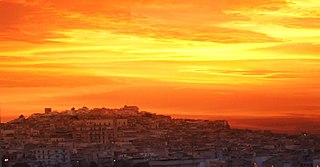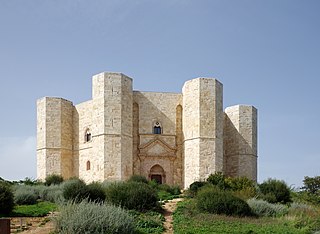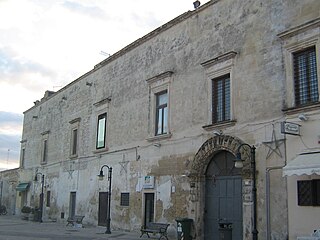
Apulia, also known by its Italian name Puglia, is a region of Italy, located in the southern peninsular section of the country, bordering the Adriatic Sea to the east, the Strait of Otranto and Ionian Sea to the southeast, and the Gulf of Taranto to the south. The region comprises 19,345 square kilometers (7,469 sq mi), and its population is about four million people. It is bordered by the other Italian regions of Molise to the north, Campania to the west, and Basilicata to the southwest. Its chief town is Bari.

Anthony of Padua, OFM or Anthony of Lisbon was a Portuguese Roman Catholic priest and friar of the Franciscan Order.
Saint Anthony, Antony, or Antonius, most often refers to Anthony of Padua, otherwise known as Saint Anthony of Lisbon, who is the patron saint of lost things in Christianity. This name may also refer to:

Canosa di Puglia, generally known simply as Canosa, is a town and comune in the province of Barletta-Andria-Trani, Apulia, southern Italy. It is located between Bari and Foggia, on the northwestern edge of the plateau of the Murgia which dominates the Ofanto valley and the extensive plains of Tavoliere delle Puglie, ranging from Mount Vulture at the Gargano, to the Adriatic coast. Canosa, the Roman Canusium, is considered the principal archaeological center of Apulia, and is one of the oldest continually inhabited cities in Italy. A number of vases and other archaeological finds are located in local museums and private collections. It is not far from the position on the Ofanto River where the Romans found refuge after the defeat of the Battle of Cannae and is the burial place of Bohemund I of Antioch.

Barletta is a city, comune of Apulia, in south eastern Italy. Barletta is the capoluogo, together with Andria and Trani, of the Province of Barletta-Andria-Trani. It has a population of around 94,700 citizens.

The Province of Barletta-Andria-Trani is a province of Italy in the Apulia region. The establishment of the province took effect in June 2009, and Andria was appointed as its seat of government on 21 May 2010.

The Ofanto, known in ancient times as Aufidus or Canna, is a 134 or 170 km river in southern Italy that flows through the regions of Campania, Basilicata, and Apulia, into the Gulf of Manfredonia near Barletta.

Andria is a city and comune in Apulia. It is an agricultural and service center, producing wine, olives and almonds. It is the fourth-largest municipality in the Apulia region and the largest municipality of the Province of Barletta-Andria-Trani. It is known for the 13th-century Castel del Monte.

Ceglie Messapica is a town, and comune, located in the province of Brindisi and region of Apulia, in southern Italy, in the traditional area called Salento.
Uva di Troia is a red wine grape variety grown in the Italian region of Apulia, particularly in the areas around Andria and Barletta, and in the Province of Bari.

The Peucetians were an Iapygian tribe which inhabited western and central Apulia in classical antiquity. Two other Iapygian tribes, the Daunians and the Messapians, inhabited northern and southern Apulia respectively. All three tribes spoke the Messapian language, but had developed separate archaeological cultures by the seventh century BC; however, in Peucetian territory ancient Greek and Oscan language were spoken as well, as the legends of the currencies from Rubi and Azetium were trilingual. Peucetians lived in the eponymous region Peucetia, which was bordered by the Ofanto river and the Murge in the north, the Bradano river in the west and the territories of the Greek colony of Taras and the Messapians in the south. This region is mostly coincident with the Metropolitan City of Bari and parts of the provinces of Taranto and Barletta-Andria-Trani today.

Magliano is a village in Apulia, on the 'heel' of Italy. It is a frazione of the comune of Carmiano in the province of Lecce and has a population of about 2500.

The Roman Catholic Archdiocese of Bari-Bitonto is Metropolitan Latin rite archbishopric in the administrative Bari province, Puglia (Apulia) region, southeastern Italy, created in 1986, when the historical diocese of Bitonto was subsumed in the Archdiocese of Bari.
The Locone is a river in the Apulia and Basilicata regions of southern Italy. The source of the river is near Spinazzola in the province of Barletta-Andria-Trani. From there, the river flows north and forms the border between the province of Barletta-Andria-Trani and the province of Potenza for a short distance. The river re-enters the province of Barletta-Andria-Trani and is joined by a left tributary flowing from the province of Potenza before entering the Ofanto south of Cerignola as a right tributary of the river.

Traditions of Italy are sets of traditions, beliefs, values, and customs that belongs within the culture of Italian people. These traditions have influenced life in Italy for centuries, and are still practiced in modern times. Italian traditions are directly connected to Italy's ancestors, which says even more about Italian history.

Tuccio d'Andria or Tuzio d'Andrea was an Italian painter.

The Metropolitan City of Bari is a metropolitan city in the Apulia region of Italy. Its capital is the city of Bari. It replaced the Province of Bari and includes the city of Bari and some forty other municipalities (comuni). It was first created by the reform of local authorities and then established by the Law 56/2014. It has been operative since January 1, 2015.

Merine is an Italian village and hamlet (frazione) of the municipality of Lizzanello in the Province of Lecce, Apulia. As of 2011 its population was of 4,785.
Strada provinciale 3 Minervino-Spinazzola , previously known as Strada regionale 6 della Murgia Centrale , is a provincial road in Apulia, the route of which takes place entirely in the province of Barletta-Andria-Trani. It has two lanes in each direction, an emergency lane and a central reservation, is free of level intersections and has a total length of about 35 km (22 mi).

Montesardo is a frazione (transl. village) in the comune of Alessano in the province of Lecce in the Apulia region, Italy. As of the 2001 census, it has a population of 1,369. It is 59 km (37 mi) from Lecce, just over 10 km (6.2 mi) from Leuca, and 1 km (0.62 mi) from the comune capital of Alessano.
















